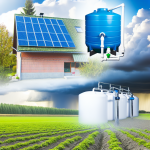Understanding the Strategic Importance of Greenhouses
In our quest for self-sufficiency, we must consider the potential impacts of unpredictable weather patterns and global food shortages. A greenhouse offers a controlled environment that can extend the growing season, ensuring a continued supply of food regardless of external conditions. This isn’t just a matter of convenience; it’s a crucial step in preparedness and survival.
Choosing the Right Type of Greenhouse
The type of greenhouse you choose can significantly affect its efficiency and productivity. Here are the most common types:
- Traditional Glass Greenhouses: While aesthetically pleasing, they are expensive and vulnerable to breakage.
- Polycarbonate Greenhouses: A more durable and insulating alternative to glass, ideal for most climates.
- Hoop Houses: Made with steel frames and plastic covers, these are cost-effective and easy to construct.
Location and Orientation
Positioning is critical. The ideal location for a greenhouse is a south-facing spot that receives maximum sunlight throughout the day. Careful consideration of wind patterns and potential snow load is essential for structural integrity and efficiency.
Maximizing the Benefits of a Greenhouse
To truly leverage a greenhouse effectively, consider the following strategies:
- Internal Climate Control: Installing fans, heaters, and proper ventilation can help manage the internal climate, making it suitable for plant growth year-round.
- Efficient Water Management: Drip irrigation or self-watering systems ensure plants receive the necessary moisture without wastage.
- Optimal Planting Techniques: Utilize vertical farming techniques to maximize space and enhance air circulation around plants.
Risks of Not Using a Greenhouse
The absence of a greenhouse in your self-sufficiency plans exposes you to several risks:
- Food Insecurity: Without a reliable year-round growing environment, your food supply becomes dependent on external, possibly unreliable sources.
- Economic Vulnerability: Fluctuating food prices can strain financial resources, especially during off-season periods.
- Reduced Nutritional Intake: Lack of fresh produce can lead to compromised health, particularly in prolonged adverse conditions.
Conclusion: Don’t Wait, Act Now
The benefits of integrating a greenhouse into your homestead far outweigh the initial investment and effort. In a world of climatic uncertainties, utilizing a greenhouse helps safeguard your food supply, providing peace of mind and contributing to a robust, resilient lifestyle. Remember, the goal of self-reliance is not just to survive, but to thrive, regardless of the circumstances faced. Ignoring the option to extend your growing season with a greenhouse isn’t just an oversight—it’s a threat to your autonomy and well-being.




GIPHY App Key not set. Please check settings